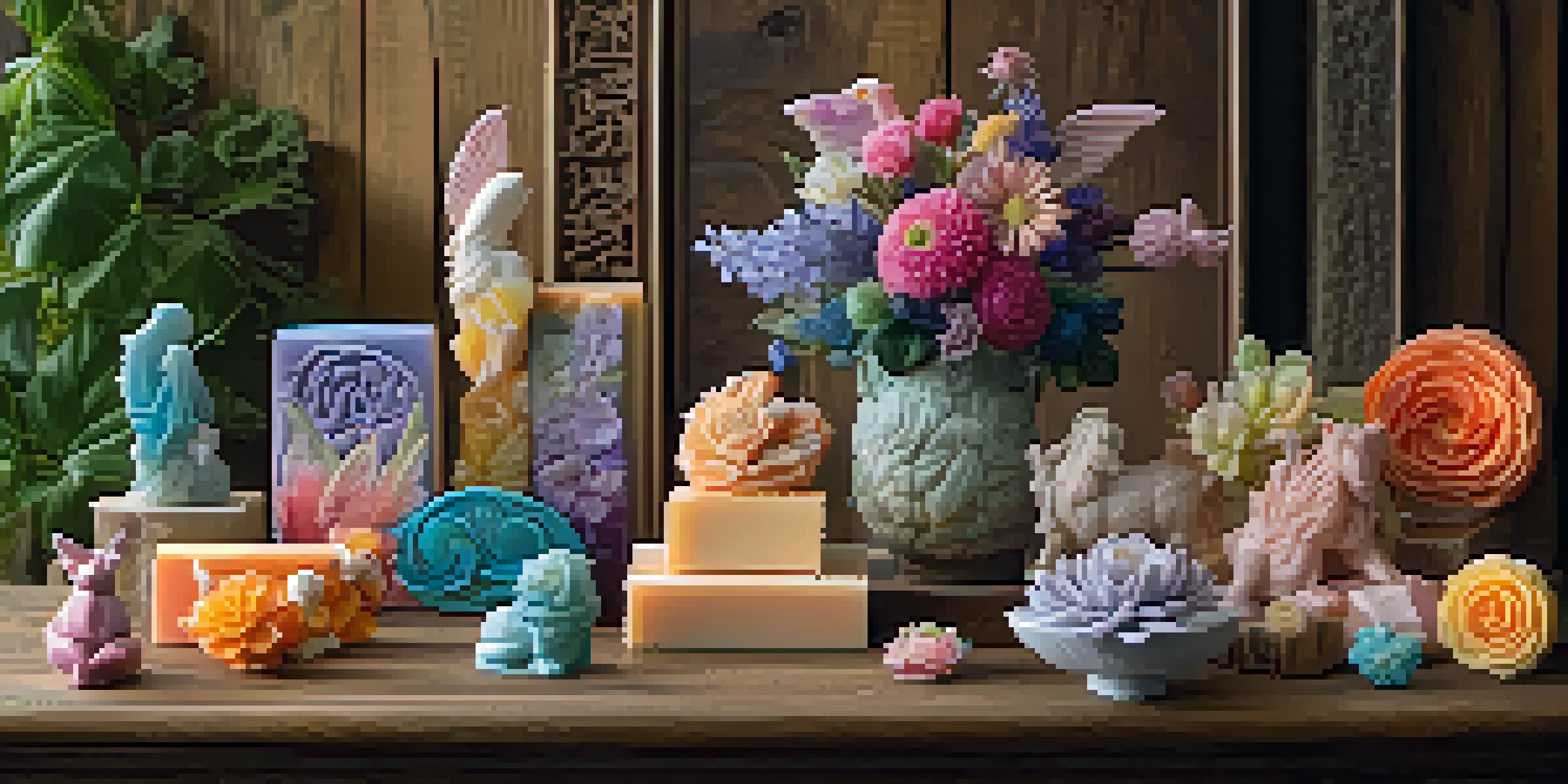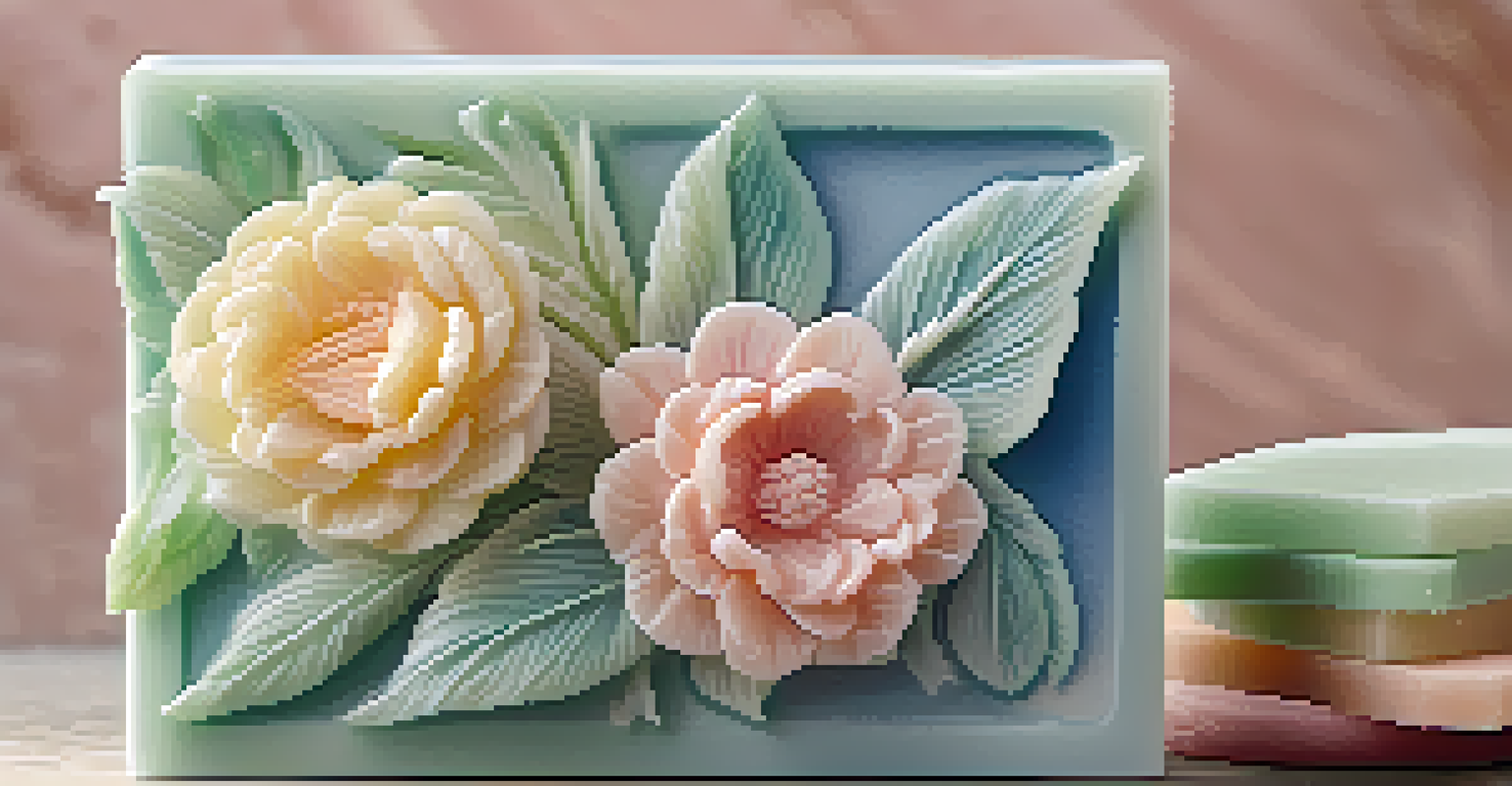The History of Soap Sculpting: From Practical to Artistic Forms

Origins of Soap: A Blend of Necessity and Discovery
Soap has been a part of human civilization for thousands of years, with the earliest evidence dating back to ancient Mesopotamia around 2800 BC. Initially, it was created from animal fats mixed with ashes and water, primarily for cleaning purposes. The practical use of soap was crucial for hygiene and health, laying the groundwork for its evolution into a medium for artistic expression.
Art is the most beautiful of all lies.
As time progressed, different civilizations, including the Egyptians and Romans, began to refine soap-making techniques. They introduced fragrances and various natural ingredients, enhancing both the aesthetic and practical aspects of soap. This shift marked the beginning of soap's journey from a mere cleaning agent to a canvas for creativity.
By the Middle Ages, soap-making became a respected craft in Europe, with guilds forming to protect the trade's secrets. The focus on quality and artistry began to emerge, setting the stage for the development of soap sculpting. This transformation illustrated how a simple necessity could inspire artistic exploration.
The Rise of Soap Sculpting in Historical Cultures
Soap sculpting can be traced back to various cultures that harnessed the medium for artistic expression. In ancient Japan, for instance, artisans created intricate soap carvings during festivals, showcasing their skills and creativity. These sculptures often represented nature and spiritual themes, illustrating the cultural significance of soap as an art form.

Similarly, during the Renaissance, European artists began experimenting with soap as a sculpture medium. They created detailed and realistic figures, often inspired by classical art and mythology. This period highlighted the potential of soap, allowing artists to explore their creativity and push the boundaries of traditional sculpture.
Soap's Artistic Evolution
From ancient cleaning agents to intricate sculptures, soap has transformed into a medium for artistic expression across cultures.
Soap sculptures from these eras were not just decorative; they served as symbols of status and wealth. Wealthy patrons commissioned these works, demonstrating how soap sculpting evolved into a respected artistic practice, blurring the lines between functionality and aesthetics.
Materials and Techniques: Crafting Soap into Art
Soap sculpting involves a variety of materials and techniques that elevate it from simple craft to fine art. Artists often choose from different types of soap, such as glycerin or cold process, each offering unique textures and properties. Understanding these materials is crucial for achieving the desired results in sculpting.
Creativity takes courage.
Techniques in soap carving can range from traditional hand-carving to modern mold-making. Some artists prefer to work with knives and chisels, while others may use tools like wire cutters for more intricate designs. This versatility allows for creativity and experimentation, enabling artists to create everything from delicate flowers to elaborate figurines.
Additionally, color and fragrance play significant roles in soap sculpting, allowing artists to create multi-sensory experiences. By incorporating natural dyes and essential oils, sculptors can enhance their works' visual appeal and aromatic qualities, making soap sculptures truly unique pieces of art.
Modern Soap Sculpting: A Blend of Tradition and Innovation
Today, soap sculpting has experienced a renaissance, with artists around the world embracing both traditional techniques and modern innovations. Social media platforms have given rise to a new generation of soap sculptors who share their creations and techniques with a global audience. This accessibility has inspired many to explore soap as a legitimate art form.
Workshops and classes dedicated to soap sculpting are becoming increasingly popular, allowing enthusiasts to learn from experienced artists. These educational opportunities emphasize the importance of technique while encouraging personal expression. This blend of learning and creativity fosters a supportive community that values both tradition and innovation.
Modern Techniques and Trends
Contemporary soap sculptors blend traditional methods with innovative practices, including eco-friendly materials and digital design.
Moreover, contemporary artists often use soap as a medium to comment on environmental issues and consumer culture. By crafting sculptures that challenge perceptions of beauty and waste, they explore deeper themes, demonstrating how soap sculpting continues to evolve and resonate in today's world.
Cultural Significance: Soap Sculpting Across the Globe
Soap sculpting holds cultural significance in various regions, reflecting local traditions and values. In some cultures, soap carvings are integral to celebrations and rituals, symbolizing purity and renewal. For example, during the Thai Songkran festival, soap sculptures are created to honor ancestors and promote good fortune.
In the Western world, soap sculpting is often associated with artisanal craftsmanship and luxury goods. Many small businesses focus on handcrafted soaps, emphasizing unique designs and high-quality ingredients. This trend has led to a resurgence of interest in soap as both a functional product and an art form, appealing to consumers who appreciate the artistry behind their purchases.
Furthermore, soap sculptures can serve as conversation starters, bridging cultural gaps and fostering connections. When displayed in galleries or public spaces, these works invite audiences to engage with the artistry and stories behind them, highlighting the universal appeal of soap sculpting across different cultures.
Challenges and Opportunities in Soap Artistry
While soap sculpting offers unique artistic opportunities, it also presents challenges for artists. The ephemeral nature of soap, which can deteriorate over time, raises concerns about the longevity of sculptures. Artists must navigate this reality, often opting for preservation techniques or creating works meant for temporary display.
Additionally, the market for soap sculptures can be competitive, requiring artists to market their work effectively. Building a brand and establishing an online presence are essential in reaching a broader audience. This challenge also encourages collaboration among artists, fostering a sense of community that can lead to new opportunities and creative endeavors.
Cultural Significance Worldwide
Soap sculpting reflects diverse cultural values and traditions, serving as a symbol of purity, creativity, and artisanal craftsmanship.
Despite these challenges, the future of soap sculpting is bright. With ongoing interest in handmade and artisanal goods, soap sculptors are finding new avenues to showcase their work, from galleries to online marketplaces. As the art form continues to evolve, it promises to inspire both artists and audiences alike.
The Future of Soap Sculpting: Trends and Innovations
Looking ahead, soap sculpting is poised for continued growth and innovation. Emerging trends include the use of sustainable and eco-friendly materials, reflecting a growing awareness of environmental issues. Artists are increasingly incorporating natural ingredients and biodegradable products into their work, appealing to conscious consumers.
Technological advancements are also influencing the field, with some artists experimenting with 3D printing and digital design. These innovations allow for precision and complexity that were once unimaginable, pushing the boundaries of traditional soap sculpting. Such developments present exciting prospects for the future of this art form.

Moreover, as the global community continues to share ideas and techniques through social media, the art of soap sculpting is likely to become more diverse and inclusive. This interconnectedness fosters creativity and encourages artists from various backgrounds to contribute their perspectives, enriching the tapestry of soap artistry.